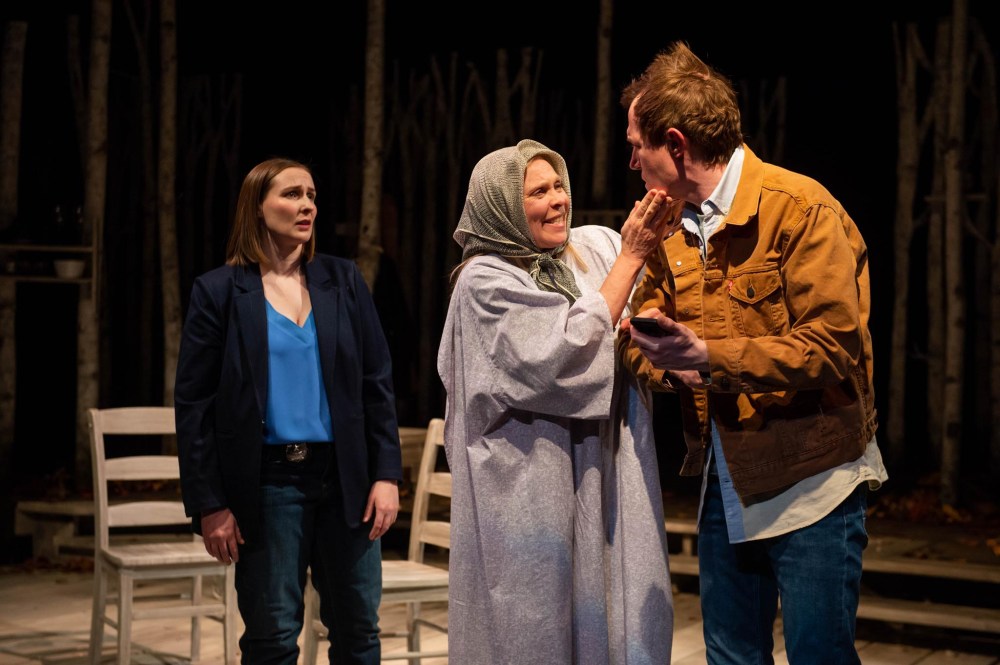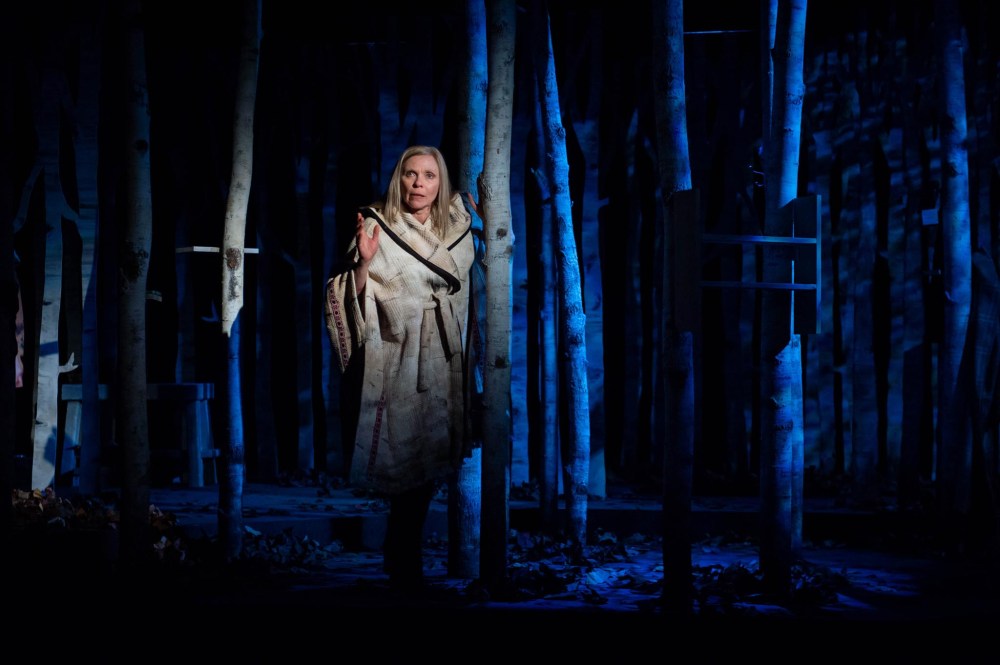Theatre review: Yaga’s twisty tale of revenge takes over MTC stage
Advertisement
Read this article for free:
or
Already have an account? Log in here »
To continue reading, please subscribe:
Monthly Digital Subscription
$0 for the first 4 weeks*
- Enjoy unlimited reading on winnipegfreepress.com
- Read the E-Edition, our digital replica newspaper
- Access News Break, our award-winning app
- Play interactive puzzles
*No charge for 4 weeks then price increases to the regular rate of $19.00 plus GST every four weeks. Offer available to new and qualified returning subscribers only. Cancel any time.
Monthly Digital Subscription
$4.75/week*
- Enjoy unlimited reading on winnipegfreepress.com
- Read the E-Edition, our digital replica newspaper
- Access News Break, our award-winning app
- Play interactive puzzles
*Billed as $19 plus GST every four weeks. Cancel any time.
To continue reading, please subscribe:
Add Free Press access to your Brandon Sun subscription for only an additional
$1 for the first 4 weeks*
*Your next subscription payment will increase by $1.00 and you will be charged $16.99 plus GST for four weeks. After four weeks, your payment will increase to $23.99 plus GST every four weeks.
Read unlimited articles for free today:
or
Already have an account? Log in here »
Hey there, time traveller!
This article was published 09/04/2023 (958 days ago), so information in it may no longer be current.
Kat Sandler’s Yaga begins and ends between the speckled branches of a placid birch-tree forest, where silhouettes dance in the fluttering dust, taking on new shapes as the angle of the moonlight shifts.
The forest is an anomalous locale, and an anonymizing one, as is the state of pure loneliness. Occupied by certain people — writers, musicians, artists, campers — the silent woods take on the form of a sylvan oasis, evoking a spirit of independence, inspiration and productivity — a place to find oneself. For others, living alone is an invitation for judgement and myth-making.
In the depths of the forest, one can only catch glimpses of the truth.

Sandler’s show gets its title from the form of Slavic folklore known as a Baba Yaga. The Baba Yaga is a matriarchal sorceress, possessing powers which shift depending on who tells the story. She is ancient, wisened, and wizened — a tempestuous and temperamental being. Generations of children in Bulgaria, Romania, Russia and Ukraine learned to fear her. It makes sense: they were told she’d eat them if they crossed her path.
So it also is logical that as she emerges from between the thickets, cast in the glow of a hidden light, the audience at the MTC Warehouse Saturday afternoon already feared Baba, as styled by the actor Marina Stephenson Kerr, based on the sheer outline of her wriggling silhouette.
The spirit of Baba Yaga is that she is a shapeshifter, and the same can be said of Stephenson Kerr, who with a subtle gnarl of her wrist provokes distrust, and with a simple turn of her heel conveys authority and sexual dominance. As Yaga, through a thick Ukrainian accent that passed the MTC audience’s muster, Stephenson Kerr serves as a pseudo-narrator.
But in this story, directed by Ann Hodges and billed as a murder-mystery comedy, the audience can never be sure who is being honest. Stephenson Kerr, along with castmates Toby Hughes and RobYn Slade, plays several roles. For Hughes and Slade, members of the seminal local improv troupe Outside Joke, this is standard practice.
Stephenson Kerr embodies six roles, including a sexy osteology professor/femme fatale, a vodka-downing grandmother, a diner owner, and a cop. Slade alternates between six roles as well, including a no-nonsense detective, a local gossip, a 15-year-old girl, and an embittered ex-girlfriend. Hughes has the fewest roles to keep track of, playing Henry, a seemingly innocent dweeb obsessed with both true and false crime, and a dawdling, horny private investigator named Charlie Rapp.
The actors capably differentiate between identities. It is no easy feat to play one role well, let alone two or six.
The show would like to lead to introspection and doubt and to play against audience expectations in order to keep them guessing. It is possible that it did both too well for the audience Saturday. At times, Sandler’s script seems so intent on the idea of character ambiguity that the story lacks enough clarity to remain engaging; with so many red herrings afloat in the stream, it can be difficult for a narrative to swim along freely.

This, of course, could be exactly what Sandler was going for — a feeling of uncertainty, forcing the audience to reconsider everything it thinks it knows about character tropes commonly deployed in police procedurals and fairy tales alike. Baba Yaga is both a witch and a healer; one person’s hocum is another’s salvation.
At its core, the show contains potent commentary on the sexualization and demonization of women, shown through a creative and dynamic reframing of victimhood. Nobody tends to ask why Yaga went to the forest: what forced her to leave society, and why she can never return. The broad brush strokes of a sexist, normative society paint a portrait of exile and othering. But sometimes, exile to the forest is self-imposed, and often, independence is self-preservational.
Perhaps the most thrilling and concerning undercurrent burbling beneath Yaga is a powerful critique of the way victims of assault, both sexual and otherwise, are inherently questioned and doubted by law enforcement, as well as the way their predators are protected by those wielding both social and political capital. Certain truths are knowingly and dangerously swept under the rug, continuing a never-ending cycle of violence, not justice.
This is brilliantly illustrated and distorted by Yaga’s first, false ending, the sharing of which does not spoil the beginning or the middle which preceded it.
While the show begins with the gnarled silhouette of a woman possessed, it ends with the crumpled shell of a man destroyed.
One of Hughes’ characters sits, covered in someone’s blood, wrapped in a towel, on the side of a winding forest path. He is panicked, and in both a physical and spiritual sense, stripped naked. Rail thin and quivering, he does not know exactly how he got there.
Approached by police officers, he begins to tell his story, which includes slaughtered poultry, magic words, and a burning funerary pyre.

JOHN WOODS / WINNIPEG FREE PRESS FILES
Marina Stephenson Kerr embodies six roles in the production ‘Yaga’, including a sexy osteology professor/femme fatale, a vodka-downing grandmother, a diner owner, and a cop.
Breathlessly, he recounts his terror.
Will anyone believe him?
ben.waldman@winnipegfreepress.com

Ben Waldman is a National Newspaper Award-nominated reporter on the Arts & Life desk at the Free Press. Born and raised in Winnipeg, Ben completed three internships with the Free Press while earning his degree at Ryerson University’s (now Toronto Metropolitan University’s) School of Journalism before joining the newsroom full-time in 2019. Read more about Ben.
Every piece of reporting Ben produces is reviewed by an editing team before it is posted online or published in print — part of the Free Press‘s tradition, since 1872, of producing reliable independent journalism. Read more about Free Press’s history and mandate, and learn how our newsroom operates.
Our newsroom depends on a growing audience of readers to power our journalism. If you are not a paid reader, please consider becoming a subscriber.
Our newsroom depends on its audience of readers to power our journalism. Thank you for your support.
History
Updated on Sunday, April 9, 2023 4:34 PM CDT: Updated headline, sentence rephrased



